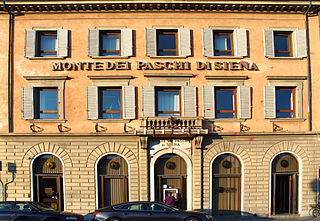
The Federal Reserve System is the central banking system of the United States. It was created on December 23, 1913, with the enactment of the Federal Reserve Act, after a series of financial panics led to the desire for central control of the monetary system in order to alleviate financial crises. Over the years, events such as the Great Depression in the 1930s and the Great Recession during the 2000s have led to the expansion of the roles and responsibilities of the Federal Reserve System.

In the United States, banking had begun by the 1780s, along with the country's founding. It has developed into a highly influential and complex system of banking and financial services. Anchored by New York City and Wall Street, it is centered on various financial services, such as private banking, asset management, and deposit security.

A financial institution, sometimes called a banking institution, is a business entity that provides service as an intermediary for different types of financial monetary transactions. Broadly speaking, there are three major types of financial institution:
- Depository institution – deposit-taking institution that accepts and manages deposits and makes loans, including bank, building society, credit union, trust company, and mortgage broker;
- Contractual institution – insurance company and pension fund
- Investment institution – investment bank, underwriter, and other different types of financial entities managing investments.

The Bank Secrecy Act of 1970 (BSA), also known as the Currency and Foreign Transactions Reporting Act, is a U.S. law requiring financial institutions in the United States to assist U.S. government agencies in detecting and preventing money laundering. Specifically, the act requires financial institutions to keep records of cash purchases of negotiable instruments, file reports if the daily aggregate exceeds $10,000, and report suspicious activity that may signify money laundering, tax evasion, or other criminal activities.

The savings and loan crisis of the 1980s and 1990s was the failure of 32% of savings and loan associations (S&Ls) in the United States from 1986 to 1995. An S&L or "thrift" is a financial institution that accepts savings deposits and makes mortgage, car and other personal loans to individual members.

The Community Reinvestment Act is a United States federal law designed to encourage commercial banks and savings associations to help meet the needs of borrowers in all segments of their communities, including low- and moderate-income neighborhoods. Congress passed the Act in 1977 to reduce discriminatory credit practices against low-income neighborhoods, a practice known as redlining.

The Office of the Comptroller of the Currency (OCC) is an independent bureau within the United States Department of the Treasury that was established by the National Currency Act of 1863 and serves to charter, regulate, and supervise all national banks and federal thrift institutions and the federally licensed branches and agencies of foreign banks in the United States. The acting Comptroller of the Currency is Michael J. Hsu, who took office on May 10, 2021.

Banking regulation and supervision refers to a form of financial regulation which subjects banks to certain requirements, restrictions and guidelines, enforced by a financial regulatory authority generally referred to as banking supervisor, with semantic variations across jurisdictions. By and large, banking regulation and supervision aims at ensuring that banks are safe and sound and at fostering market transparency between banks and the individuals and corporations with whom they conduct business.

The Depository Institutions Deregulation and Monetary Control Act of 1980 is a United States federal financial statute passed in 1980 and signed by President Jimmy Carter on March 31. It gave the Federal Reserve greater control over non-member banks.

The Home Mortgage Disclosure Act is a United States federal law that requires certain financial institutions to provide mortgage data to the public. Congress enacted HMDA in 1975.

The Federal Financial Institutions Examination Council (FFIEC) is a formal U.S. government interagency body composed of five banking regulators that is "empowered to prescribe uniform principles, standards, and report forms to promote uniformity in the supervision of financial institutions". It also oversees real estate appraisal in the United States. Its regulations are contained in title 12 of the Code of Federal Regulations.

The Financial Institutions Reform, Recovery, and Enforcement Act of 1989 (FIRREA), is a United States federal law enacted in the wake of the savings and loan crisis of the 1980s.
All regulated financial institutions in the United States are required to file periodic financial and other information with their respective regulators and other parties. For banks in the U.S., one of the key reports required to be filed is the quarterly Consolidated Report of Condition and Income, generally referred to as the call report or RC report. Specifically, every National Bank, State Member Bank and insured Nonmember Bank is required by the Federal Financial Institutions Examination Council (FFIEC) to file a call report as of the close of business on the last day of each calendar quarter, i.e. the report date. The specific reporting requirements depend upon the size of the bank and whether or not it has any foreign offices. Call reports are due no later than 30 days after the end of each calendar quarter. Revisions may be made without prejudice up to 30 days after the initial filing period. Form FFIEC 031 is used for banks with both domestic (U.S.) and foreign (non-U.S.) offices; Forms FFIEC 041 and 051 is for banks with domestic (U.S.) offices only.

The Right to Financial Privacy Act of 1978 is a United States federal law, Title XI of the Financial Institutions Regulatory and Interest Rate Control Act of 1978, that gives the customers of financial institutions the right to some level of privacy from government searches.
Bank regulation in the United States is highly fragmented compared with other G10 countries, where most countries have only one bank regulator. In the U.S., banking is regulated at both the federal and state level. Depending on the type of charter a banking organization has and on its organizational structure, it may be subject to numerous federal and state banking regulations. Apart from the bank regulatory agencies the U.S. maintains separate securities, commodities, and insurance regulatory agencies at the federal and state level, unlike Japan and the United Kingdom. Bank examiners are generally employed to supervise banks and to ensure compliance with regulations.

A bank is a financial institution that accepts deposits from the public and creates a demand deposit while simultaneously making loans. Lending activities can be directly performed by the bank or indirectly through capital markets.

The Office of the Commissioner of Financial Institutions of Puerto Rico—in Spanish: Oficina del Comisionado de Instituciones Financieras (OCIF)—is an office of the Department of Treasury of Puerto Rico that supervises and regulates Puerto Rico's financial sector to ensure its safety and soundness, as well as to oversee a strict adherence to all applicable laws and regulations. The OCIF as a regulatory body is similar in function to the State Banking Departments found in the 50 states. However, Puerto Rico being a commonwealth territory, its functions and legal enforcement are more broad as it is empowered to issue banking licenses under Puerto Rico law which are not under direct federal supervision, such as International Banking Entities and International Finance Entities. The OCIF follows examination guidance issued by the Federal Financial Institutions Examination Council (FFIEC), a formal interagency body empowered to prescribe uniform principles for the examination of financial institutions in the U.S., including institutions regulated by the Federal Reserve Board of Governors and the Office of the Comptroller of the Currency (OCC). Ángel Luis Rosas Collazo served as its first commissioner.

The Federal Reserve Reform Act of 1977 enacted a number of reforms to the Federal Reserve, making it more accountable for its actions on monetary and fiscal policy and tasking it with the goal to "promote maximum employment, production, and price stability". The act explicitly established price stability as a national policy goal for the first time. It also required quarterly reports to Congress "concerning the ranges of monetary and credit aggregates for the upcoming 12 months." It also modified the selection of the Class B and C Reserve Bank Directors. Discrimination on the basis of race, creed, color, sex, or national origin was prohibited, and the composition of the directors was required to represent interests of "agriculture, commerce, industry, services, labor and consumers". The Federal Reserve Act, which created the Federal Reserve in 1913, made no mention of services, labor, and consumers. Finally, the act established Senate confirmation of chairmen and vice chairmen of the Board of Governors of the Federal Reserve. The Federal Reserve Reform Act made the Federal Reserve more transparent to Congressional oversight.
This article details the history of banking in the United States. Banking in the United States is regulated by both the federal and state governments.

Deborah "Debbie" Matz is an American civil servant who served as the 8th Chairman of the National Credit Union Administration.










